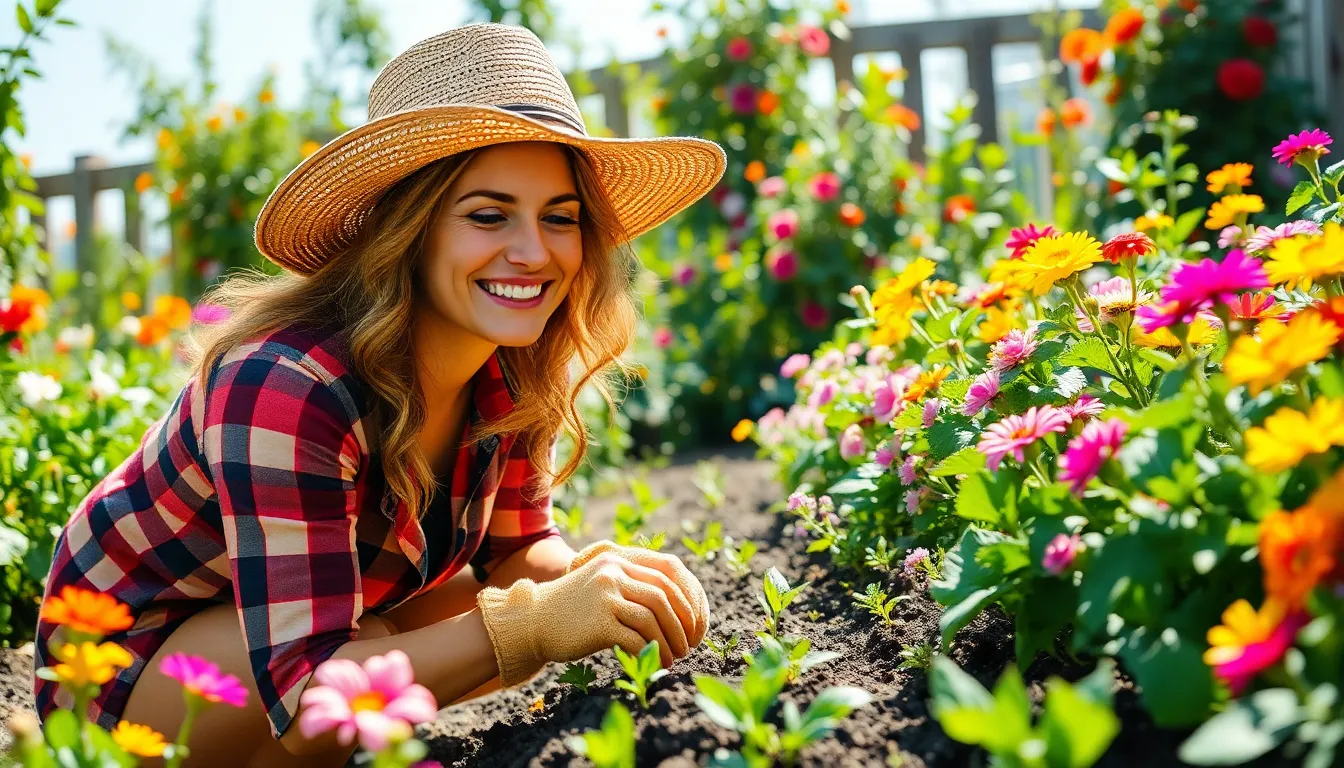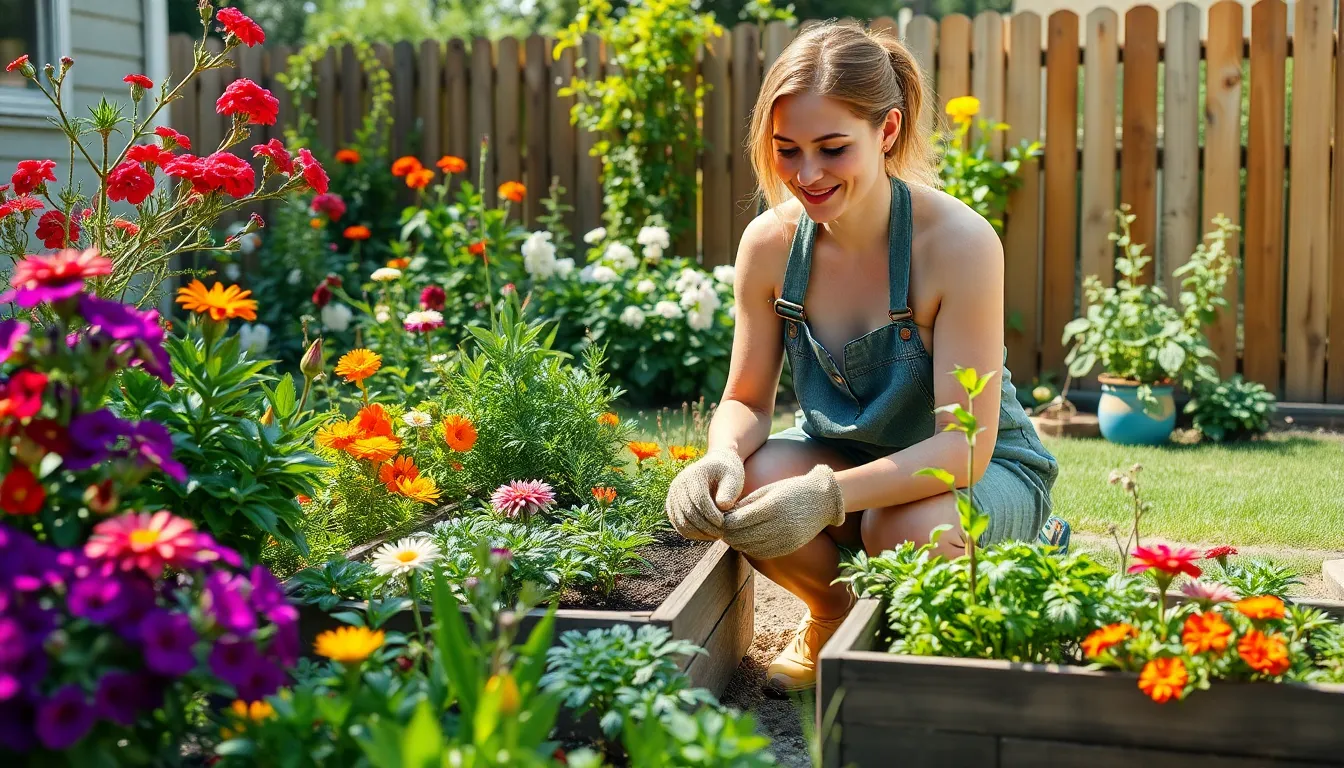Creating a vibrant home garden is more than just a hobby; it’s a way to enhance living spaces and promote well-being. With a little creativity and planning, anyone can transform their outdoor area into a lush sanctuary. From small balconies to sprawling backyards, the possibilities are endless, inviting both relaxation and inspiration.
Home gardening not only beautifies a space but also encourages sustainability. Growing fresh herbs, vegetables, and flowers can bring joy and satisfaction, while also contributing to a healthier lifestyle. Whether someone is a seasoned gardener or a beginner, exploring innovative garden ideas can spark enthusiasm and lead to the perfect green retreat right at home.
Table of Contents
ToggleHome Garden Ideas: An Overview
Home gardening offers diverse opportunities for individuals to create unique outdoor spaces. Various garden styles cater to different tastes and practical needs, enhancing both aesthetics and functionality.
Container Gardens
Container gardens suit small spaces, allowing for flexibility in arrangements. These gardens can include herbs, flowers, and vegetables grown in pots or raised beds, maximizing limited areas.
Vertical Gardens
Vertical gardens utilize wall space effectively, creating lush greenery without occupying ground space. They consist of plants arranged on structures such as frames or trellises, making them ideal for urban settings.
Herb Gardens
Herb gardens provide fresh culinary ingredients just steps away from the kitchen. These gardens can thrive in small plots or containers, featuring herbs like basil, parsley, and mint, which are easy to cultivate.
Raised Bed Gardens
Raised bed gardens improve drainage and soil quality, making them suitable for various plants. They allow better access for maintenance and offer a more organized growing space compared to in-ground gardens.
Pollinator Gardens
Pollinator gardens attract beneficial insects and birds, fostering biodiversity. These gardens include native flowers that provide habitats and food sources, contributing to a balanced ecosystem.
Water Feature Gardens
Water features, such as ponds or fountains, add tranquility and visual interest to home gardens. Incorporating water elements can create a serene atmosphere while supporting varied plant and animal life.
Edible Landscaping
Edible landscaping combines aesthetics and food production, integrating vegetables and fruits into traditional landscape designs. This approach enhances outdoor beauty while ensuring a sustainable food source.
Zen Gardens
Zen gardens promote relaxation and mindfulness through minimalist landscapes. Utilizing gravel, sand, and strategically placed stones, these gardens offer a contemplative space for reflection.
By exploring these various home garden ideas, individuals can transform their outdoor areas into vibrant ecosystems that support personal well-being and sustainability.
Benefits of Home Gardening

Home gardening offers numerous advantages that enhance physical health and boost mental well-being. Individuals reap these benefits through engaging in gardening activities and cultivating various plants.
Physical Health Advantages
Engaging in home gardening contributes significantly to physical activity. Activities such as planting, weeding, and harvesting provide moderate exercise that increases strength and flexibility while burning calories. Studies indicate that gardening can burn approximately 200-400 calories per hour, making it an effective workout alternative.
Growing one’s own food promotes healthier eating habits. Home gardeners can access fresh vegetables, herbs, and fruits, which contain essential vitamins and nutrients. Furthermore, consuming homegrown produce reduces reliance on store-bought items, often laden with pesticides and preservatives. Access to organic food encourages better nutrition and overall health.
Mental Wellbeing Benefits
Home gardening fosters mental well-being by reducing stress and anxiety levels. Spending time outdoors and connecting with nature contributes to relaxation and tranquility. Research shows that interacting with plants can lower cortisol levels, the hormone linked to stress.
Gardening also promotes mindfulness. Individuals focus on the present moment, observing plant growth and observing the surrounding environment, which can elevate mood and lead to feelings of accomplishment. Engaging with plants encourages creativity, allowing gardeners to express their personalities and preferences in their outdoor spaces.
Together, these physical health advantages and mental well-being benefits position home gardening as a rewarding activity that enhances quality of life while supporting a sustainable lifestyle.
Designing Your Home Garden
Designing a home garden requires thoughtful planning and consideration of available space and plant selection. Proper design transforms outdoor areas into inviting, functional spaces that enhance overall well-being.
Choosing the Right Space
Choosing the right space for a garden involves assessing sunlight, accessibility, and size. Areas that receive at least six hours of direct sunlight daily are ideal for most plants. If outdoor space is limited, consider options like balconies, patios, or window boxes. Accessibility plays a crucial role; paths should allow easy maintenance and enjoyment of the garden. Measurements ensure the selected space accommodates the desired plants and layout, preventing overcrowding and enhancing garden aesthetics.
Selecting Suitable Plants
Selecting suitable plants depends on climate, available sunlight, and the gardener’s skill level. Native plants thrive in local conditions, requiring less maintenance and water. For beginners, starting with easy-to-grow options like lettuce, tomatoes, and herbs, such as basil and mint, offers quick rewards. Gardeners may consider seasonal plants to keep the garden vibrant year-round. Diversity in plant selection can attract pollinators and beneficial insects, promoting a healthy ecosystem. Using a combination of perennials and annuals ensures continuous bloom and interest throughout different seasons.
Creative Home Garden Ideas
Home gardens offer creativity alongside functionality. Implementing unique gardening concepts can enhance outdoor experiences, regardless of space constraints.
Container Gardening
Container gardening utilizes pots and planters for growing plants in limited spaces. This method fits balconies, patios, or small yards, allowing for blooms and herbs in confined areas. Selecting lightweight materials for containers reduces strain during rearrangement. Various plants, such as succulents, herbs, and flowering plants, thrive well in containers. Utilizing self-watering containers helps maintain moisture levels, simplifying care. Aligning colors and textures creates an appealing visual array, complementing outdoor aesthetic.
Vertical Gardens
Vertical gardens transform walls and fences into greenery displays. By using trellises or wall-mounted planters, individuals maximize space while adding depth to outdoor areas. This approach suits urban settings, where horizontal space is limited. Climbing plants, such as ivy and peas, flourish upwards and enhance verticality. Furthermore, incorporating edible varieties, like strawberries or herbs, combines aesthetics with functionality. Adopting modular systems allows for adjustable layouts, catering to changing tastes and seasonal needs. Proper irrigation systems ensure all plants receive adequate nutrients, promoting healthy growth.
Seasonal Considerations
Seasonal changes significantly influence home gardening strategies. Adapting gardening practices to different times of the year maximizes production and enhances plant health.
Spring Planting Tips
Spring marks the ideal time for renewal in home gardens. Selecting the right plants for spring planting can set the stage for a successful growing season.
- Choose hardy varieties. Plant resilient species like peas, lettuce, and spinach as they thrive in cooler temperatures.
- Prepare soil early. Amend soil with compost to improve fertility and promote strong root development.
- Start seeds indoors. Germinate heat-loving plants such as peppers and tomatoes inside for transplanting later when temperatures rise.
- Timing matters. Assess local frost dates to schedule planting effectively, ensuring young plants thrive without frost damage.
Winter Garden Maintenance
Winter maintenance helps protect investments and prepares gardens for the coming spring.
- Mulch effectively. Apply a layer of organic mulch to insulate soil and regulate temperature, reducing weed growth.
- Prune strategically. Trim back perennials and shrubs to encourage healthy growth while removing dead or damaged wood.
- Plan for next season. Review garden successes and failures, noting what worked well and what needs improvement for planning spring planting.
- Protect plants. Utilize row covers or cloches to shield sensitive plants from harsh winter conditions, enhancing their survival rate.
Creating a home garden offers a unique opportunity to enhance personal spaces while promoting well-being. By exploring various styles and innovative ideas, anyone can cultivate their own green sanctuary. Whether it’s a compact container garden on a balcony or a serene Zen garden in the backyard, each design serves a purpose and adds beauty.
Embracing home gardening not only supports sustainability but also fosters a deeper connection with nature. Engaging in this rewarding activity can lead to healthier lifestyles and improved mental health. With thoughtful planning and a touch of creativity, transforming outdoor areas into vibrant ecosystems becomes an achievable goal. The journey of gardening invites exploration and enjoyment, making it a fulfilling endeavor for all.




